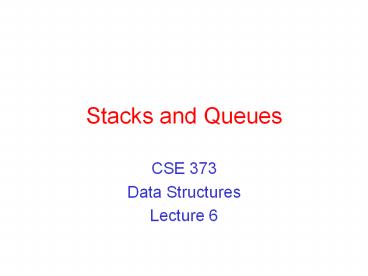Stacks and Queues - PowerPoint PPT Presentation
Title:
Stacks and Queues
Description:
Stacks and Queues CSE 373 Data Structures Lecture 6 Readings Reading Sections 3.3 and 3.4 Stack ADT A list for which Insert and Delete are allowed only at one end of ... – PowerPoint PPT presentation
Number of Views:154
Avg rating:3.0/5.0
Title: Stacks and Queues
1
Stacks and Queues
- CSE 373
- Data Structures
- Lecture 6
2
Readings
- Reading
- Sections 3.3 and 3.4
3
Stack ADT
- A list for which Insert and Delete are allowed
only at one end of the list (the top) - the implementation defines which end is the "top"
- LIFO Last in, First out
- Push Insert element at top
- Pop Remove and return top element (aka
TopAndPop) - IsEmpty test for emptyness
a tray stack
4
An Important Application of Stacks
- Parsing phase in compilers
- yields the reverse Polish (postfix) notation
- abcd (traversal of a binary tree in
postorder see Lecture 7)
parse tree
d
(ab)cd
c
a b
5
Another Important Application of Stacks
- Call stack in run time systems
- When a function (method, procedure) is called the
work area (local variables, copies of parameters,
return location in code) for the new function is
pushed on to the stack. When the function
returns the stack is popped. - So, calling a recursive procedure with a depth of
N requires O(N) space.
6
Two Basic Implementations of Stacks
- Linked List
- Push is InsertFront
- Pop is DeleteFront (Top is access the element
at the top of the stack) - IsEmpty is test for null
- Array
- The k items in the stack are the first k items in
the array.
7
Linked List Implementation
- Stack of blobs
null
a blob
node
Pointer to next node
Pointer to blob
8
Array Implementation
- Stack of blobs
A
top
bottom
1 2 3 4 5 6 7 8
9 10 11 12
4
12
holder blob pointer array size number in
stack maxsize max size of stack
9
Push and Pop (array impl.)
IsEmpty(A blobstack pointer) boolean
return A.size 0 IsFull(A blobstack pointer)
boolean return A.size A.maxsize Pop(A
blobstack pointer) blob pointer //
Precondition A is not empty // A.size
A.size 1 return A.holderA.size
1 Push(A blobstack pointer, p blob
pointer) // precondition A is not full//
A.size A.size 1 A.holderA.size p
10
Linked Lists vs Array
- Linked list implementation
- flexible size of stack can be anything
- constant time per operation
- - Call to memory allocator can be costly
- Array Implementation
- Memory preallocated
- constant time per operation.
- - Not all allocated memory is used
- Overflow possible - Resizing can be used but some
ops will be more than constant time.
11
Queue
- Insert at one end of List, remove at the other
end - Queues are FIFO first in, first out
- Primary operations are Enqueue and Dequeue
- A queue ensures fairness
- customers waiting on a customer hotline
- processes waiting to run on the CPU
12
Queue ADT
- Operations
- Enqueue - add an entry at the end of the queue
(also called rear or tail) - Dequeue - remove the entry from the front of the
queue - IsEmpty
- IsFull may be needed
13
A Sample of Applications of Queues
- File servers Users needing access to their files
on a shared file server machine are given access
on a FIFO basis - Printer Queue Jobs submitted to a printer are
printed in order of arrival - Phone calls made to customer service hotlines are
usually placed in a queue
14
Pointer Implementation
Q
front
rear
null
Header Not always there
front rear
15
List Implementation
IsEmpty(Q blobqueue pointer) boolean
return Q.front Q.rear Dequeue(Q blobqueue
pointer) blob pointer // Precondition Q is
not empty // B blob pointer B
Q.front.next Q.front.next
Q.front.next.next return B Enqueue(Q
blobqueue pointer, p blob pointer)
Q.rear.next new node Q.rear
Q.rear.next Q.rear.value p
16
Array Implementation
- Circular array
front
rear
Q
0 1 2 3 4 5 6 7
8 9 10 11
4
2
12
holder blob pointer array size number in
queue front index of front of queue maxsize
max size of queue
rear (front size) mod maxsize
17
Wrap Around
front
Q
rear
0 1 2 3 4 5 6 7
8 9 10 11
4
10
12
rear (front size) mod maxsize (10
4) mod 12 14 mod 12 2
18
Enqueue
front
Q
rear
0 1 2 3 4 5 6 7
8 9 10 11
4
10
12
p
19
Enqueue
front
Q
rear
0 1 2 3 4 5 6 7
8 9 10 11
5
10
12
p
20
Enqueue
Enqueue(Q blobqueue pointer, p blob pointer)
// precondition queue is not full
// Q.holder(Q.front Q.size) mod Q.maxsize
p Q.size Q.size 1
Constant time!
21
Dequeue
front
Q
rear
0 1 2 3 4 5 6 7
8 9 10 11
4
10
12
22
Dequeue
Q
front
rear
0 1 2 3 4 5 6 7
8 9 10 11
3
11
12
return
23
Try Dequeue
- Define the circular array implementation of
Dequeue
24
Solution to Dequeue
Dequeue(Q blobqueue pointer) blob pointer
// precondition queue is not empty // p
blob pointer p Q.holderQ.front Q.front
(Q.front 1) mod Q.maxsize Q.size Q.size -
1 return p

